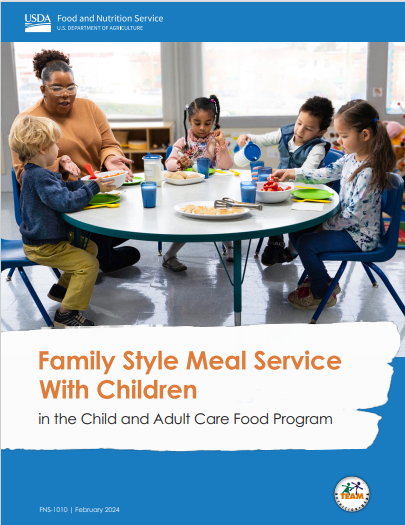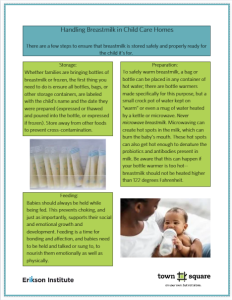If you are curious about family style dining, whether or not you’re currently on the food program, this short booklet will show you all the equipment you need, how to introduce the idea to children and their families, and tips for ensuring compliance with CACFP regulations.
Family Style Meal Service With Children in the Child and Adult Care Food Program (cacfp.org)
Handling, storing, heating, and feeding breastmilk can feel like it has a lot of steps.
This printable PDF reviews how to safely provide breastmilk to infants whose families provide it, including storage, preparation, and feeding. Below, you’ll also find a video from Head Start showing an Early Head Start teacher bottle feeding an infant and demonstrating responsive feeding and interaction with a baby at feeding time.
Gestión de la leche materna en cuidado de los niños
What do you notice in this video of the Early Head Start teacher feeding the baby? How does the baby respond to her actions and speech?
March 28th, 2024
2:00-2:30 PM EDT
Encourage young ones to share their thoughts and stories as they gather around the dining table- family style. This interactive experience fosters not only healthy eating habits but also helps them learn the art of conversation, where little voices can be heard and cherished. Receive tips on how to make family style dining kid-friendly and discover resources to start conversing with children at the table!
Isabel Ramos-Lebron, MS,RDN, LD
Nutrition Education Specialist
National CACFP Sponsors Association
Family Style Dining: Conversations Around the Table – Event Registration (growthzoneapp.com)
The important but routine tasks involved in ensuring children’s needs are met through each day. Care tasks may include feeding, diapering, toileting, washing, dressing/undressing, putting a child to sleep, and more. The time spent with children during these routines can be some of the most valuable for connection if adults take the time to involve the child, talk to the child, and make it enjoyable.
Providing balanced meals and snacks for children can be a challenge. Accommodating different preferences while remaining aligned with CACFP requirements and offering a variety of nutritious foods without large portions winding up in the trash might seem like a distant dream. Often, feeding concerns are really just a venue for power struggle. So how can we help children feel empowered to make their own choices at meal times? Try some of these tips, and see if the emotional climate of your meals changes.
Family style meals: instead of plating food for the children, teach and then allow them to serve their own portions. Even young toddlers can learn to scoop fruit or vegetables onto their own plate, and as they get older, they can build towards pouring beverages. If you’re concerned about your CACFP monitor, 7 CFR 226.20 — Requirements for meals states that when meals are served family style, “A sufficient amount of prepared food must be placed on each table to provide the full required portions of each of the components… for all children or adults at the table and to accommodate supervising adults if they wish to eat with the children and adults.” This means that even if a child initially takes a smaller portion of food than would be required if you had plated it, it still counts as long as there is enough food for them to have taken the full portion.
Modify tools to help children serve themselves: I’ve found that a recycled coffee creamer bottle is a great first tool for pouring milk or water, because the spout is very small and the bottle itself is easy to hold and hard to break. Some other easy and fun ways to help children serve their own food include small tongs or measuring cups, which have higher edges than serving spoons and can facilitate more food getting to the intended dish.
Collaborate with families or look around the world for inspiration for variety. Ask families what their children’s favorite meals are and what their favorite meals were as children. Try the same dish inspired by different cultures. Italian meatballs one week, albondigas the next, and Swedish meatballs after that!
Offer condiments: you can let children serve themselves (try smaller bottles with very small nozzles to prevent spills and overuse) or offer a pre-filled cup of sauce or dressing on the side for children to dip or pour over their food. An empty saltshaker on the table for children to use can also give a sense of autonomy without risking oversalted food.
Invite children to help you plan meals: Bring out the circulars and have them circle a fruit or vegetable they’d like to try. Make sure to give credit when you do serve it– “Thank you for picking out these big green kiwis to try at lunch today, Saamya!”
Don’t shy away from seasoning food well! While we may have an image of children preferring bland foods, often the taste they’re looking to avoid is “bitter”. That leaves a whole world of flavors to explore. Try lemony green beans; add cinnamon, turmeric, and black pepper to sweet potatoes; jazz up cooked zucchini with garlic and a sprinkle of parmesan.
Consider the Divison of Responsibility in Feeding, which states that it’s the adult’s job to offer balanced and nutritious meals, and the child’s job to decide how much of a food– if any– they’ll eat, and listen to their body’s cues. Remember that mealtimes are a way to build community. We don’t just eat for fuel; we share food, memories, and time together. When children are encouraged to participate, but not forced to clean their plate or eat something they dislike, they learn lifelong healthy habits.
Like the Early Childhood Nutrition Improvement Act, this proposal will benefit family child care providers who participate in the CACFP.
It will:
- Provide an additional 10 cent reimbursement for each meal and snack served in the CACFP
- Eliminate the tiering of family child care homes
- Allow family child care home providers to claim their own children’s meals for reimbursement
- Shift the calculation of family child care homes’ reimbursement from “food at home” to “food away from home” to align with centers
Click here to send a letter of support to your representative!
On October 26, the Early Childhood Nutrition Improvement Act (H.R.6067) was re-introduced in the House of Representatives by Congresswoman Suzanne Bonamici (D-OR) and Congressman Marc Molinaro (R-NY). This bipartisan legislation would:
- Allow providers who are open for more than 8 hours in a day to be reimbursed for an additional meal (up to 3 meals and 1 snack).
- Align the calculation of reimbursement rates for family child care homes with that of centers by shifting to “food away from home.”
- Allow annual eligibility for for-profit child care centers to streamline program operations.
This would make a huge difference in children’s nutrition and providers’ bottom lines.
Read More Here from the CACFP!
Click here to send a letter of support to your representative!
For more opportunities to advocate for yourself and your fellow providers, read about the Child Care Nutrition Enhancement Act here!
The Centers for Disease Control and Prevention (CDC) has some resources available to help maintain healthy eating in your family child care home. There are links and information for adults about how to “Go Further with Food” during National Nutrition Month. There are also resources for older school-age children on the Body and Mind (BAM) page, including these great healthy recipes that children can help prepare.
The Illinois Child Care Bureau (ICCB) sponsors reimbursement for the Child and Adult Care Food Program (CACFP), a program funded by the US Department of Agriculture that provides partial reimbursement for providing healthy meals and snacks to the children in your care. The site includes free training for FCC professionals to qualify for the CACFP program and offers menus, recipes, and directions for reimbursement.






